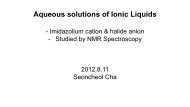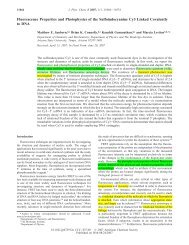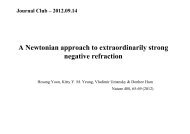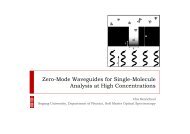Melting Behavior of Poly(L lactide)
Melting Behavior of Poly(L lactide)
Melting Behavior of Poly(L lactide)
You also want an ePaper? Increase the reach of your titles
YUMPU automatically turns print PDFs into web optimized ePapers that Google loves.
the peak p shift to lower wavenumber <strong>of</strong> C=O band<br />
linear change<br />
I 1759 increase<br />
drastic increase <strong>of</strong> I 1749<br />
Fi Figure 8 8. ( (a) ) DSC hheating i curve,<br />
temperature-dependent (b) wavenumber<br />
<strong>of</strong> the C=O stretching band, and (c)<br />
normalized intensity <strong>of</strong> the 1759 and 1749<br />
Figure 9b<br />
cm-1 bands for PLLA118 isothermally<br />
meltcrystallized at Tc = 80°Cduring the<br />
heating process at a rate <strong>of</strong> 2 °C/min.<br />
Figure 9a<br />
increase <strong>of</strong> the content <strong>of</strong> the amorphous phase<br />
C=O band shifts toward lower wavenumber














